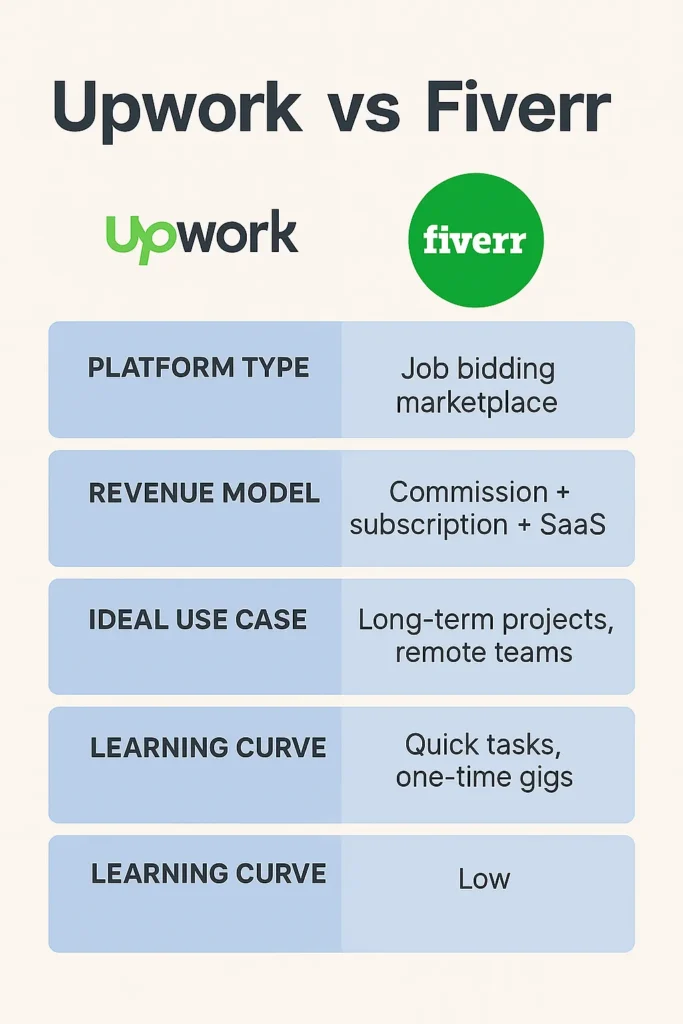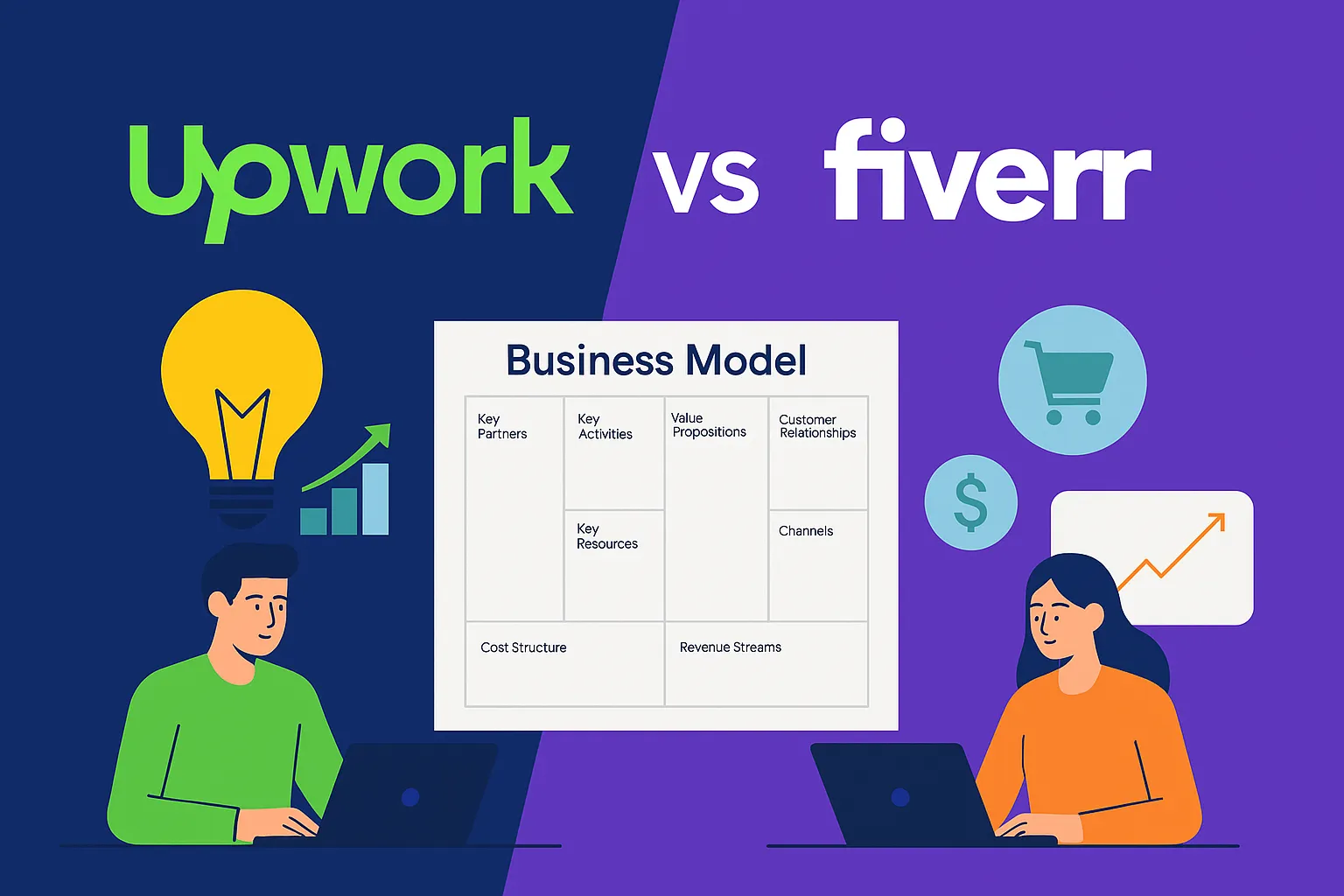In today’s digital-first economy, freelancing platforms have become cornerstones of the gig economy. With remote work becoming a default mode of operation for millions of professionals and startups alike, platforms like Upwork and Fiverr are playing crucial roles in connecting businesses with global talent.
For startup founders and app entrepreneurs looking to build the next freelance marketplace, understanding how these industry leaders operate—particularly their business models—can inform better decisions around monetization, user experience, scalability, and growth.
So, which model should you clone, tweak, or innovate on in 2025? This in-depth comparison will help you answer that question based on real-world performance, strategic structures, revenue streams, and future scalability potential.

What is Upwork?
Upwork is a freelancing marketplace that connects businesses with skilled professionals across the globe. Founded through a merger of Elance and oDesk in 2015, Upwork focuses on long-term projects, remote teams, and enterprise-level talent solutions.
Key features include:
- Job bidding and proposals
- Hourly or fixed-price contracts
- Built-in time tracking and reporting tools
- Talent marketplace and project catalogs
- Enterprise offerings for large organizations
What is Fiverr?
Fiverr, launched in 2010, started with a revolutionary concept—freelance services starting at $5. Over the years, it evolved into a full-fledged on-demand digital services platform, popular for one-time gigs such as logo design, video editing, and copywriting.
Key features include:
- Gig-based service listings
- Tiered service packages (Basic, Standard, Premium)
- Instant purchase & checkout
- Seller profiles and reviews
- Fiverr Business suite for team usage
Business Model of Upwork
Upwork follows a two-sided marketplace model that monetizes interactions between clients and freelancers.
Revenue Model
- Service Fees:
- Freelancers: Sliding scale from 20% (first $500) to 5% (above $10,000) per client.
- Clients: 5% fee on payments made, with a 3% fee on enterprise payments.
- Subscription Plans:
- Freelancer Plus ($14.99/month): For better visibility.
- Client Premium Plans: Custom pricing for enhanced features.
- Enterprise Solutions:
- Dedicated tools, compliance features, and reporting for large teams.
Cost Structure
- Platform maintenance
- Payment processing fees
- Compliance & dispute resolution
- Talent matching algorithm upkeep
- Customer support & marketing
Key Partners
- Payment gateways (PayPal, Payoneer)
- Compliance vendors (ID verification)
- Cloud service providers
- API & software partners for integration
Growth Strategy
- Expansion into enterprise-level hiring
- Focus on long-term contracts
- Continuous AI-based matching improvements
- Offering white-glove services for enterprises
Learn More: Upwork Features Every Startup Should Know About
Business Model of Fiverr
Fiverr uses an on-demand gig model where freelancers list services and clients buy instantly—like eCommerce.
Revenue Model
- Service Fees:
- Buyers: 5.5% of the total order value.
- Sellers: Flat 20% commission on all orders.
- Fiverr Business ($149/year):
- Includes collaboration tools for teams.
- Promoted Gigs:
- Paid visibility for freelancers.
- Fiverr Learn:
- Upskilling platform generating additional revenue.
Cost Structure
- Hosting and infrastructure
- Payment processing fees
- Talent acquisition and marketing
- Platform development and seller support
Key Partners
- Financial institutions (Stripe, PayPal)
- SaaS tools for analytics and marketing
- Upskilling and educational content creators
Growth Strategy
- Brand building via influencer marketing
- Expansion into e-learning and business tools
- Automation and AI enhancements for recommendations
- Global gig expansion with localization
Learn More: Top Fiverr Features That Power Freelance Platforms
Upwork vs Fiverr – Comparison Table
| Feature | Upwork | Fiverr |
| Platform Type | Job bidding marketplace | On-demand gig marketplace |
| Revenue Model | Commission + subscription + SaaS | Commission + subscription + ads |
| Commission Fee | 5–20% (freelancer) + 5% (client) | 20% (freelancer) + 5.5% (client) |
| Ideal Use Case | Long-term projects, remote teams | Quick tasks, one-time gigs |
| Project Structure | Hourly or milestone-based | Package-based |
| Enterprise Solutions | Yes | Yes |
| Ease of Use | Moderate | Very easy |
| Learning Curve | Steep | Low |
Pros & Cons of Upwork Business Model
Pros
- Trusted for long-term, high-value contracts
- Effective enterprise partnerships
- Tiered commission promotes client loyalty
- Advanced time tracking and compliance tools
Cons
- Complex bidding process can overwhelm new users
- High service fees deter some freelancers
- Reliance on long-form proposals reduces instant conversion
Pros & Cons of Fiverr Business Model
Pros
- Easy to use and instantly monetizable for freelancers
- Streamlined for quick service delivery
- Gig packages simplify pricing and scope
- Highly scalable for micro-services
Cons
- Limited project flexibility (no hourly/milestone options)
- Harder for freelancers to form long-term client relationships
- High competition drives price undercutting
Market Data: Growth, Revenue & Funding
| Metric | Upwork | Fiverr |
| Founded | 2015 | 2010 |
| Market Cap (2025) | ~$1.4B | ~$850M |
| 2024 Revenue | $670M+ | $370M+ |
| Funding Raised | ~$170M pre-IPO | ~$111M pre-IPO |
| Geographic Focus | US, Canada, Europe, Asia | US, Israel, Global (localized) |
| Public Listing | Nasdaq: UPWK | NYSE: FVRR |
Which Model is Better for Startups in 2025?
The answer depends entirely on your niche, audience behavior, and monetization goals:
- Want to build a platform for ongoing freelance teams, tech talent, or agency-style work? Go for the Upwork model.
- Planning to launch a micro-gig platform, creative freelancer hub, or marketplace for digital tasks? Choose the Fiverr model.
Both models have proven sustainable and scalable, but Fiverr’s simplicity and transactional focus make it easier to launch, while Upwork’s depth makes it great for premium offerings and repeat users.
Choose Upwork-Style If…
You’re building a freelance marketplace focused on:
- Tech jobs, software development, IT, or virtual assistants
- Long-term remote work engagements
- Complex workflows with time tracking or milestones
- Enterprise integrations
Launch Your Own Upwork Clone with Miracuves
Choose Fiverr-Style If…
You’re planning a gig-based app for:
- Creative services, design, video, voiceover, etc.
- Quick delivery or on-demand solutions
- Tiered service packaging
- Global micro-task workers
Get Your Own Fiverr Clone Platform with Miracuves
Conclusion
Both Fiverr and Upwork have unlocked billions in freelance value. As a startup founder or platform builder, your job is to select the model that fits your users, market, and monetization vision.
At Miracuves, we offer ready-made clone solutions, custom development, and scalable architecture to help you bring your freelance platform idea to life—fast and efficiently.
FAQs
1. What’s the main difference between Fiverr and Upwork business models?
Fiverr is gig-based with fixed pricing, while Upwork is project-based and allows for hourly or milestone billing.
2. Which platform is easier to replicate for a startup?
Fiverr’s model is simpler and more suitable for MVPs or quick-launch platforms.
3. Can both models be combined in one platform?
Yes, hybrid models are emerging in 2025 that combine bidding + instant gigs for versatility.
4. Which is more profitable: Fiverr or Upwork?
Profitability depends on user retention, market size, and your monetization strategy. Upwork has higher-value contracts; Fiverr has higher volume.
5. Does Miracuves offer both Fiverr and Upwork clone scripts?
Yes, Miracuves offers fully customizable Fiverr Clone and Upwork Clone solutions tailored for startup needs.








